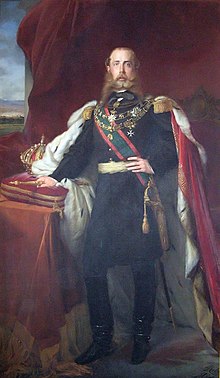Maximillian of Mexico
| Maximilian I | |||||
|---|---|---|---|---|---|

Emperor Maximilian around 1865
|
|||||
| Emperor of Mexico | |||||
| Reign | 11 July 1863 – 19 June 1867 | ||||
| Predecessor | Monarchy re-established (Benito Juárez, President of Mexico) |
||||
| Successor | Monarchy abolished (Benito Juárez, President of Mexico) |
||||
| Regent | |||||
| Born |
6 July 1832 Schönbrunn, Vienna, Austria |
||||
| Died | 19 June 1867 (aged 34) Cerro de las Campanas, Santiago de Querétaro, Mexico |
||||
| Burial | Imperial Crypt, Vienna, Austria | ||||
| Spouse | Charlotte of Belgium | ||||
|
|||||
| House | Habsburg-Lorraine | ||||
| Father | Archduke Franz Karl of Austria | ||||
| Mother | Princess Sophie of Bavaria | ||||
| Religion | Roman Catholicism | ||||
| Signature | |||||
| Full name | |
|---|---|
| Ferdinand Maximilian Joseph |
|
Styles of Maximilian I of Mexico |
|
|---|---|
 |
|
| Reference style | His Imperial Majesty |
| Spoken style | Your Imperial Majesty |
| Alternative style | Sire |
Maximilian (Spanish: Maximiliano; born Ferdinand Maximilian Joseph; 6 July 1832 – 19 June 1867) was the only monarch of the Second Mexican Empire. He was a younger brother of the Austrian emperor Francis Joseph I. After a distinguished career in the Austrian Navy, he accepted an offer by Napoleon III of France to rule Mexico. France (along with the United Kingdom and Spain, who both withdrew the following year after negotiating agreements with Mexico's democratic government) had invaded the Mexican Republic in the winter of 1861, as part of the War of the French Intervention. Seeking to legitimize French rule in the Americas, Napoleon III invited Maximilian to establish a new Mexican monarchy for him. With the support of the French army, and a group of conservative Mexican monarchists hostile to the liberal administration of new Mexican President Benito Juárez, Maximilian traveled to Mexico. Once there, he declared himself Emperor of Mexico on 10 April 1864.
The Empire managed to gain recognition by major European powers including Britain, Austria, and Prussia. The United States however, continued to recognize Juárez as the legal president of Mexico. Maximilian never completely defeated the Mexican Republic; Republican forces led by President Benito Juárez continued to be active during Maximilian's rule. With the end of the American Civil War in 1865, the United States (which had been too distracted by its own civil war to confront the Europeans' 1861 invasion of what it considered to be its sphere of influence) began more explicit aid of President Juárez's forces. Matters worsened for Maximilian after the French armies withdrew from Mexico in 1866. His self-declared empire collapsed, and he was captured and executed by the Mexican government in 1867. His wife, Charlotte of Belgium (Carlota), had left for Europe earlier to try to build support for her husband's regime; after his execution, she suffered an emotional collapse and was declared insane.
...
Wikipedia
